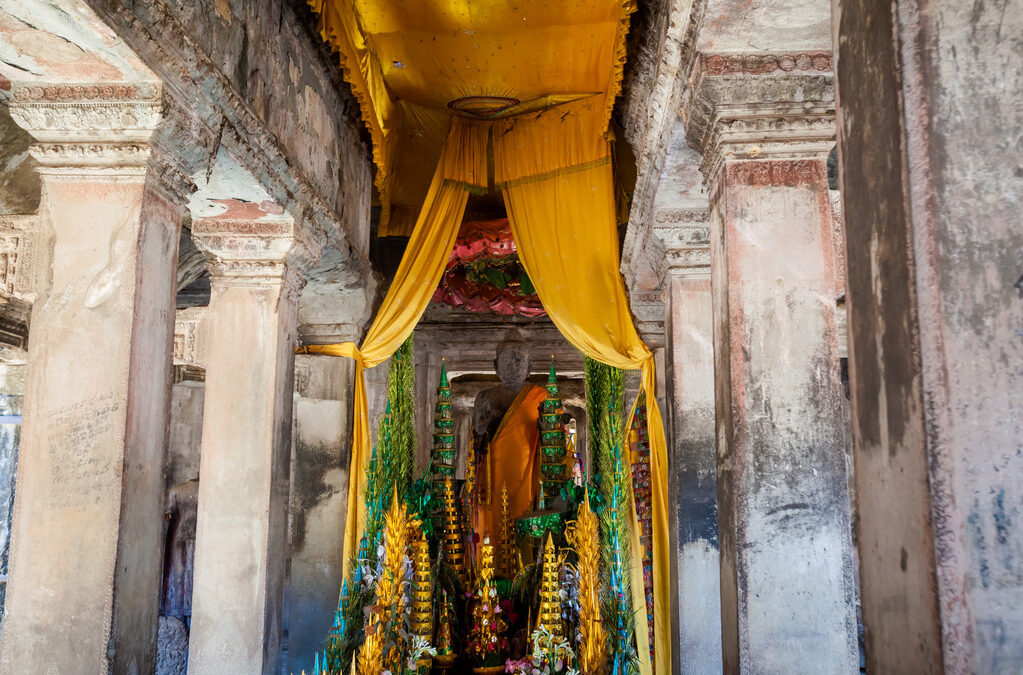You’ll find an incredible spiritual fusion at Angkor Wat, where Hindu and Buddhist traditions have harmoniously coexisted since the 12th century. Originally built as a Hindu temple dedicated to Vishnu, it gradually adopted Buddhism while preserving its Hindu elements. The five central towers still represent Mount Meru, while monks now chant both Sanskrit mantras and Buddhist sutras in its sacred halls. This architectural marvel’s dual heritage offers fascinating insights into Southeast Asia’s rich religious evolution.
Key Takeaways
- Angkor Wat evolved from a Hindu temple dedicated to Vishnu into a shared sacred space incorporating Buddhist elements over centuries.
- The temple’s architecture combines Hindu symbolism of Mount Meru with Buddhist stupas and statues in a unique spiritual fusion.
- Detailed bas-reliefs throughout the temple complex showcase both Hindu epics and Buddhist narratives, reflecting religious coexistence.
- Modern ceremonies at Angkor Wat blend Hindu processions with Buddhist offerings, demonstrating continuous spiritual harmony.
- The temple remains an active pilgrimage site where both Hindu and Buddhist worshippers freely practice their faith.
The Sacred Origins of Angkor Wat
Rising majestically from the Cambodian landscape, Angkor Wat stands as one of humanity’s most awe-inspiring architectural achievements. When King Suryavarman II commissioned this massive temple in 1116 C.E., he wasn’t just building a place of worship – he was creating a masterpiece of sacred architecture that would connect earth to heaven!
You’ll find divine symbolism in every corner of this incredible structure. The five central towers mirror Mount Meru, the mythical home of the gods, while the surrounding moat represents the cosmic ocean.
What’s fascinating is that unlike other temples of its time, Angkor Wat faces west – possibly linking it to Vishnu or suggesting its role as the king’s final resting place. The temple’s precise astronomical alignments show you’re not just looking at a building – you’re experiencing a carefully crafted model of the universe itself.
From Hindu Temple to Buddhist Sanctuary
Though Angkor Wat began its life as a magnificent Hindu temple dedicated to Vishnu, you’ll be fascinated to learn how it transformed into one of Buddhism’s most significant sanctuaries!
You’re witnessing history in motion when you investigate the temple’s evolution. The transformation wasn’t sudden – it took centuries of gradual change, starting around the 9th century. As Buddhist monks arrived and cultural exchanges flourished, the temple’s ritual significance evolved.
You’ll notice how cleverly they integrated Buddhist stupas and statues while preserving the original Hindu architecture.
Buddhist elements gracefully merged with Hindu foundations, creating a harmonious architectural blend that speaks to both faiths’ enduring legacies.
What makes this site truly remarkable is how it tells two historical narratives at once. The original Hindu bas-reliefs stand proudly alongside Buddhist enhancements, creating a unique spiritual blend that’s distinctly Cambodian.
Today, you can still experience this remarkable fusion as both Hindu and Buddhist pilgrims continue to worship at this sacred site!
Architectural Symbolism Through Two Faiths
When you investigate Angkor Wat’s magnificent architecture, you’ll uncover an incredible fusion of Hindu and Buddhist symbolism that’s unlike anything else in Southeast Asia! The architectural motifs tell a fascinating story of spiritual significance through every carefully planned detail.
You’ll find the temple’s five towers rising majestically to represent Mount Meru, the sacred mountain in Hindu cosmology. The surrounding moat isn’t just for defense – it symbolizes the mythical oceans of Hindu tradition!
As you examine the concentric galleries, you’re actually walking through a physical representation of mountain ranges that circle Mount Meru.
What makes this place truly special is how seamlessly Buddhist elements were integrated into the original Hindu design. You’re witnessing a remarkable demonstration of Cambodia’s ability to blend two great faiths while preserving the architectural harmony of both traditions.
Religious Art and Iconography Evolution
Throughout Cambodia’s artistic evolution, you’ll uncover an incredible transformation of religious art that seamlessly weaves together Hindu and Buddhist influences! You can witness this fascinating blend in over 900 temples, where religious symbolism and artistic techniques merge to create something distinctly Cambodian.
Cambodia’s rich artistic heritage showcases a masterful fusion of Hindu and Buddhist elements across hundreds of ancient temples.
Ancient artists mastered stone carving, terracotta, and bronze work to bring their spiritual visions to life.
Here’s what makes Cambodian religious art so special:
- Integration of Buddhist statues into Hindu temples
- Detailed bas-reliefs depicting both Hindu epics and Buddhist narratives
- Distinct Khmer style blending Indian techniques with local artistry
- Use of slender lines and serene expressions in Buddhist sculptures
- Preservation of Hindu elements even as Buddhism became dominant
Watch how these spiritual traditions dance together in everything from temple carvings to festival celebrations – it’s artistic freedom at its finest!
Royal Patronage and Spiritual Transformation
The royal patronage of Cambodia’s ancient kings shaped more than just temples – it revolutionized the entire spiritual landscape!
You’ll find their divine authority expressed through every inch of Angkor Wat, where royal symbolism merges with cosmic design.
When King Suryavarman II commissioned Angkor Wat, he wasn’t just building a temple – he was creating a powerful declaration of his divine right to rule!
The temple’s stunning central tower represents Mount Meru, placing you at the heart of Hindu cosmology.
But here’s what makes it truly fascinating: as Buddhism gained influence in the 15th century, the temple didn’t lose its Hindu elements.
Instead, you’ll uncover how both faiths blend seamlessly, with Buddhist statues standing alongside Hindu imagery.
It’s a reflection of Cambodia’s incredible ability to adopt spiritual transformation while honoring its roots.
Cultural Fusion in Temple Ceremonies
Standing at the heart of Cambodia’s spiritual heritage, Angkor Wat‘s ceremonies offer you a mesmerizing display of cultural fusion that’s unlike anything else in Southeast Asia!
The temple’s ceremonial practices seamlessly blend Hindu and Buddhist traditions, creating an atmosphere where you’ll witness both ancient and contemporary ritual significance coming alive.
You’ll uncover these incredible elements that make Angkor Wat’s ceremonies unique:
- Annual festivals combining Hindu processions with Buddhist offerings
- Local communities actively participating in time-honored spiritual rituals
- Elaborate ceremonies honoring both Vishnu and Buddha
- Traditional dance performances incorporating both religious narratives
- Sacred chanting that blends Sanskrit mantras with Buddhist sutras
You’re not just observing history – you’re experiencing a living tradition where two great faiths have created something extraordinary together.
It’s a powerful reminder of how spiritual freedom can lead to beautiful cultural harmony!
Preservation of Dual Religious Heritage
Preserving Angkor Wat’s unique dual religious heritage presents an extraordinary challenge that you won’t find anywhere else in Southeast Asia!
As you investigate this magnificent temple, you’ll witness directly how heritage conservation efforts maintain both Hindu sculptures and Buddhist enhancements in perfect harmony.
You can’t miss the remarkable way the site honors both faiths – from the empty Northeast corner (that’s Shiva’s special spot!) to the carefully preserved Buddhist statues that were incorporated centuries later.
Faith preservation here isn’t just about maintaining stones; it’s about protecting the incredible story of how two religions peacefully coexist.
Thanks to organizations like APSARA and UNESCO, you’re able to experience this spiritual fusion exactly as generations before you have – with all its Hindu motifs and Buddhist elements working together in architectural symphony.
Sacred Spaces and Ritual Practices
Moving beyond preservation, sacred spaces within Cambodia’s temples reveal an extraordinary tapestry of living faith practices that you can still witness today!
You’ll find a fascinating blend of Hindu and Buddhist sacred rituals seamlessly woven throughout these ancient structures, reflecting centuries of spiritual evolution.
Here’s what makes these sacred spaces so unique:
- Daily Buddhist ceremonies amid Hindu architectural elements
- Intricate bas-reliefs depicting both religious and everyday life scenes
- Ancient healing rituals still practiced at Neak Pean’s mythical pools
- Living traditions of spiritual practices at Angkor Wat’s shrines
- Symbolic representations merging Hindu-Buddhist iconography
Whether you’re exploring Bayon’s enigmatic faces or witnessing monks performing ceremonies at Angkor Wat, you’re experiencing a remarkable fusion of spiritual practices that’s survived for centuries.
It’s a reflection of Cambodia’s incredible religious harmony!
Modern Pilgrimage and Tourism Impact
While ancient temples continue to serve as sacred spaces, they’re now at the heart of Cambodia’s thriving tourism industry! You’ll find yourself among 421,379 fellow international visitors who’ve made spiritual odysseys to Angkor Archaeological Park in early 2024 – that’s a whopping 41% increase from last year!
| Experience Type | Traditional | Modern Tourism |
|---|---|---|
| Purpose | Sacred ritual | Cultural discovery |
| Access | Limited | Open to all |
| Activities | Prayer & meditation | Photos & guided tours |
| Impact | Spiritual growth | Economic enhancement |
Whether you’re drawn by Buddhist pilgrimages or cultural curiosity, you’re part of a transformation that’s bringing $19.9 million in revenue while creating thousands of local jobs. Thanks to the new Siem Reap Angkor International Airport, with its impressive 3,600-meter runway, you’ll find it easier than ever to discover these sacred-meets-modern spaces!
Legacy of Religious Harmony at Angkor
Beyond the bustling tourism at Angkor Wat lies a remarkable story of religious harmony that’s shaped Cambodia’s spiritual identity for centuries.
You’ll uncover how this architectural marvel became a living proof of peaceful spiritual dialogues between Hindu and Buddhist traditions.
When you investigate Angkor’s sacred spaces, you’ll find these remarkable examples of harmony:
- Original Hindu designs seamlessly blend with Buddhist modifications
- Ancient bas-reliefs tell stories from both religious traditions
- Sacred ceremonies from both faiths continue to this day
- Local pilgrims worship freely, regardless of their beliefs
- Cultural narratives from both religions are similarly respected
This extraordinary blend isn’t just about the past – it’s a blueprint for modern religious harmony!
The temple’s transformation from a Hindu sanctuary to a Buddhist shrine shows how different faiths can enrich rather than conflict with each other.
Conclusion
When you visit Angkor Wat today, you’ll witness something truly remarkable – a sacred space where Hindu and Buddhist traditions don’t just coexist, they blend seamlessly! This architectural marvel showcases how two major faiths can harmoniously share one holy site. You’re not just exploring an ancient temple; you’re experiencing a living representation of religious tolerance that’s shaped Cambodia’s spiritual identity for nearly a millennium.



